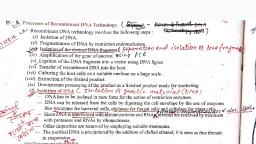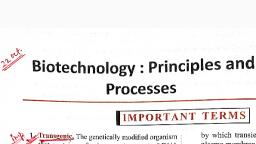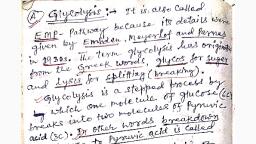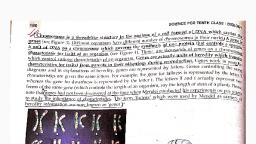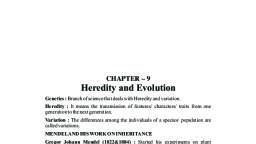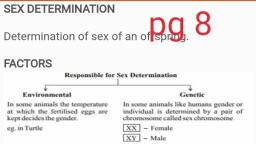Page 1 :
while discussing the determination of sex of a child, we use letter, chromosomes rather than individual genes.The sex chromosomes arc, XX for a female (girl), XY for a male (boy), , symDols, , 1C5CII, , Wnole SCx, , Sex Determination, person can have a maie sex or a female sex.(The, process by which the sex of a person is determined, is called sex determination.,Genetics is involved in, the determination of the sex of a person. This can be, explained as follows., A, , The chromosomes which, , determine the sex ofa, person are called sex chromosomes.jThere are twa, , Y, types of sex chromosomes, one is called X chromoSome, and the other is called Y chromosomej, X, () A male (man or father) has one X chromosome, X, and one Y chromosome [see Figure 20(«)]. This means (a) The human male (man or (b)The human female (woman, father) has one X chromoor mother) has two X, that half the male gametes or half the sperms will have, some and one Y chromosome, chromosomes., X, , chromosomes and the other half will have, , Y, , Figure 20. The sex chromosomes., chromosomes., (i) A female (woman or mother) has two X chromosomes, (but no Y chromosomes) [see Figure 20(b)]., This means that all the female gametes called ova (or, eggs) will have only X chromosomes., The sex of a child depends on what happens at fertilisation (aIf a sperm carrying, X chromosome, fertilises an ovum (or egg) which carries X chromosome,, then the child born will bea girl (or female). This, is because the child will have XX combination of sex, chromosomes (see Figure 21)., Paeytatetks, Phenotype, P4eta, Total No, , XFemale, male's, spermsS, X, , x, , y, , typeC, , Fuslon, , m, , e, , Mother's, , Father's sperms, , eggs (or ova), , (Half X;, Half Y), , (All X), , X, DryUpeJ, , u, , þeinas, , 46, (R3) 23) Pairs, , gamtos, XX, , XX, , Cmmosma, man, , XY, , Xy, , XX zygote, (Female child: Girl), , XY, , (22) +(1), , zygote, , (Malechild: Boy), , Kutesm, , sex, , chtmAy, , Figure 21. Inheritance of sex in humans., , Cin Case (ale, , b) If a sperm carrying Y chromosome fertilises an ovum egg), which carries X chromosome,, (or, then the, child horn will be a boy(or male). This is because the child will have XY combination, of sex chromosome, es, (see Figure 21)..
Page 2 :
HEREDI, , 191, note that it is(the sperm which, determines the sex of the, child. This is because half of the, hav X chromosomes and the other half, chave, sperms, Y, have chromosomes. Thus,, A and a 50 per cent chance, there is a 50 per cent chance of, of, a girl being born to the, boy, parents.)This is why the human, roughly half males and half females., population is, Erom the above discussion we conclude that if the, father (man or husband), contributes X sex chromosomne, Gortilsation through his sperm, the baby born will, be a girl. On the other, hand, if the father (man or, hnsband) contributes a Y sex, chromosome at fertilisation through his, sperm, then the baby born will be a, hov, This means that it is the sex chromosome, contributed by father (man or husband), sex, which decides the, of, baby, the, sex, which the mother (woman or wife) will give birth, to.[Thus, father (man or husband) is, esponsible, sex, re, of the baby (boy or girl) which is, for the, born.The bélief thát mother (woman or wife) is, responsible for the sex of her baby is abso/utely w, rong. In many ignorant Indian families, the, S, woman, mother, or wite) is held responsible for the birth of a girl child, and unnecessarily harassed by her in-laws, (sSaSural). Such, people should understand that it is the husband who is, responsible for the birth of a girl, child (and not his wife). Moreover,, a girl is no less Hhan a boy., some of the animals, sex determination is also controtted by, environmental factors. For example,, the, in some reptiles, the temperature at which the fertilised, egg is incubated before hat¢hing, plays a role in, determining the sex of the offspring. It has been found that in, aturtle Chrysema yicta), high incubation, temperatureleads to the development of female offsprings (or female, progeny). Oh the other hand, in the, case of a lizard (Agama agama), high incubation temperature, results in male offsprings (or male progeny)., In some animals, such as snails, individuals can change sex,, indicating that sex is not determined genetically, in such animals.Before we go furtl:er and discuss, acquired and inherited traits of organisms, please answer, thefollowing questions:, Dlease, , n









